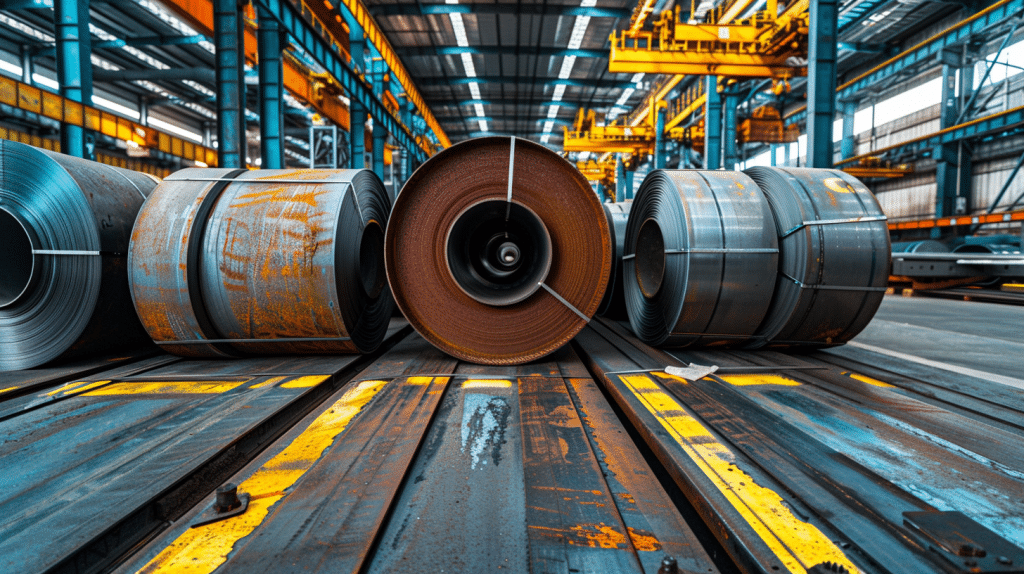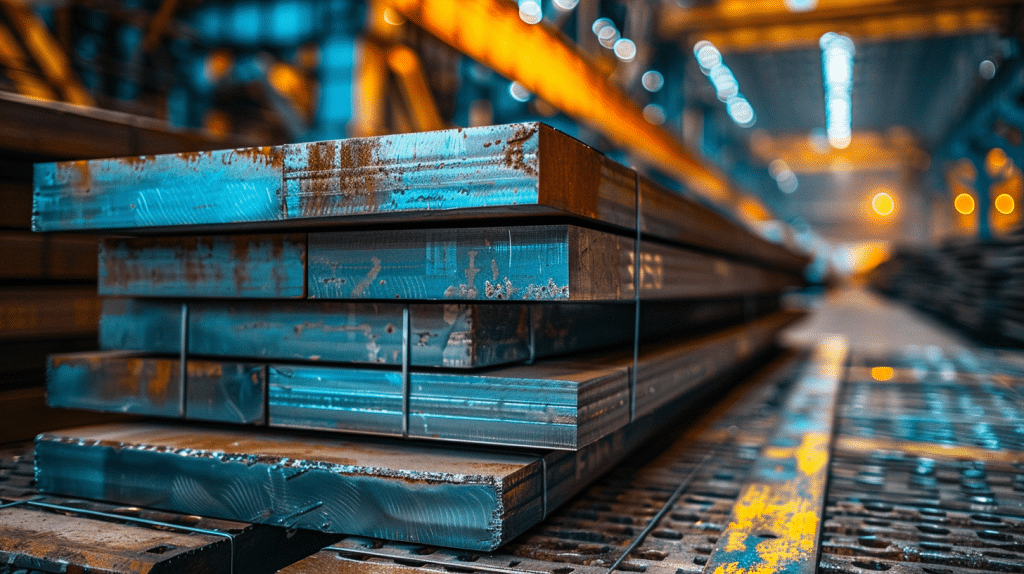In the realm of tool and mold-making materials, H13 steel and P20 steel stand out as prominent choices, each offering unique properties tailored for specific applications. Understanding the differences between these two types of steel is crucial for engineers, designers, and manufacturers to make informed decisions on the right material for their particular needs. This article aims to provide a comprehensive comparison of H13 steel versus P20 steel, covering their chemical composition, mechanical properties, heat treatment processes, and typical applications.

What Is H13 Steel
H13 steel is a versatile, chromium-molybdenum alloy used extensively in the manufacturing and industrial sectors due to its excellent balance of high toughness, resistance to thermal fatigue, and good red hardness. This hot-work tool steel is known for its ability to withstand rapid cooling from high working temperatures without losing its hardness.
The composition and properties of H13 steel make it highly suitable for demanding applications where tools and molds are subjected to severe thermal cycles during processing. It is often selected for its performance in hot environments, which can be attributed to its well-balanced alloying elements that provide increased hardness and durability.
One of the defining characteristics of H13 steel is its adaptability in various heat treatment processes. It can be air-hardened, which simplifies the quenching process considerably compared to more traditional methods that require oil or water quenching. This air hardening capability significantly reduces the risks associated with cracking during the cooling phase post-quenching.
Moreover, H13 steel exemplifies exceptional resistance to thermal fatigue by retaining critical properties over extended exposure periods at elevated temperatures. This attribute makes it particularly valuable for applications involving cyclic temperature variations within a short time span, such as die casting and forging.
H13 steel’s combination of adaptability, resilience at high temperatures, and reliability under fluctuating thermal conditions renders it an indispensable resource across various fields requiring precision under stress. Its notable features contribute significantly to this material’s selection as a first-choice solution for complex industrial applications facing intense thermal demands.
What Is H13 Steel Made Of?
- Iron (Fe): Majority component, forms the base of H13 steel.
- Chromium (Cr): Typically around 5%, increases hardness and resistance to wear and corrosion.
- Molybdenum (Mo) and Vanadium (V): Each around 1% or less, enhance strength and high-temperature resistance, refine grain structure, and improve toughness.
- Silicon (Si): Usually under 1%, boosts strength, acts as a deoxidizer during manufacturing for cleaner steel.
- Carbon (C): Around 0.4%, crucial for achieving optimal hardness through heat treatment while managing brittleness.
- Magnesium and Sulfur: Present minimally, primarily enhance machinability without significant alteration of other characteristics.
Applications Of H13 Steel
- Tooling Industry: H13 steel finds extensive application in the tooling industry, particularly in the manufacturing of forging dies, die-casting tools, extrusion dies, and injection molds. Its remarkable characteristic of enduring repeated heating and cooling cycles without compromising its integrity makes it highly preferred in these applications.
- Die Casting for Non-Ferrous Metals: In die casting processes involving materials like aluminum and other non-ferrous metals, H13 steel demonstrates exceptional performance due to its resistance to thermal shock. This property makes it highly suitable for such demanding applications.
- Aerospace Sector: H13 steel plays a significant role in the aerospace industry, where components such as turbine parts and landing gear require materials capable of withstanding high temperatures and stress. Its excellent toughness and durability at elevated temperatures make it a preferred choice for such critical applications.
- Plastic Molding Industry: H13 steel is favored in the plastic molding industry for constructing molds subjected to abrasive plastics and those requiring a high polish. It ensures extended mold life and consistent performance under challenging conditions, making it an ideal material for this sector.
- Other Applications: H13 steel’s adaptability extends to various other applications such as the production of hot work punches, drill bits, and high-speed stamping tools. Its ability to maintain strength at high temperatures makes it suitable for cutting tools and other applications where heat buildup is frequent.
Mechanical and Thermal Properties of H13 Steel
The mechanical properties of H13 steel underscore its robustness. It boasts a high level of toughness which is essential in resisting rapid cracking and chipping upon impact or under heavy loads. This characteristic ensures durability and longevity in tools and dies exposed to constant stress. The hardness of H13 steel is another critical attribute, typically measuring around 52-54 HRC (Rockwell Hardness) when tempered. This level of hardness is conducive to maintaining sharp edges and resisting abrasion effectively.
When it comes to thermal properties, H13 steel exhibits exceptional performance. Its ability to withstand heat check resistance up to approximately 600°C makes it ideal for use in hot-work applications. This property ensures that the material does not easily succumb to cracking or softening when exposed to high temperatures, maintaining its structural integrity over time. Moreover, H13 steel showcases superior thermal conductivity allowing for efficient heat dissipation during processes like die-casting and forging.
In addition, the thermal shock resistance of H13 steel is noteworthy. It can withstand sudden changes in temperature without compromising its mechanical properties or leading to failures such as cracks or dimensional instability. This resilience against thermal shock plays a significant role in enhancing the lifetime of tools crafted from this material.
Given these attributes, it becomes evident why H13 steel finds widespread use across various industries where durability under harsh working conditions is paramount. Its combination of mechanical robustness alongside excellent thermal properties renders it an advisable choice for high-performance applications requiring reliability under stringent operating scenarios.

What Is P20 Steel
P20 steel is a versatile, pre-hardened plastic mold steel that is recognized for its outstanding balance between toughness and machinability. It falls under the category of low-alloy tool steels and is primarily utilized in the plastics industry due to its ability to be machined into intricate shapes while maintaining good dimensional stability. This particular type of steel has carved out a niche for itself among mold makers and manufacturers who require materials that can withstand prolonged cycles of heating and cooling without compromising structural integrity.
The composition of P20 steel plays a crucial role in defining its mechanical properties and applications. Typically, it includes elements such as chromium, manganese, molybdenum, and carbon which contribute to its hardness and resistance to wear. Its unique chemical makeup allows P20 to be used in an annealed condition, providing a consistent working material that doesn’t necessitate additional heat treatments post-machining. This quality often leads to significant savings in terms of time and production costs for manufacturing processes.
One of the distinctive features of P20 steel is its excellent weldability compared with many other tool steels. This characteristic makes it particularly valuable for large molds or those requiring modifications or repairs. Its ability to be polished to a high finish also contributes to its popularity in the creation of molds intended for producing aesthetically critical components such as lenses, consumer electronics housings, and automotive dashboards.
When considering what P20 steel is and its inherent characteristics, it becomes clear that this material offers a harmonious blend of strength, ductility, and machinability. These attributes make P20 an optimal choice for various applications within the mold making industry along with other sectors requiring precision parts with excellent surface finishes.
What Is P20 Steel Made Of?
- Carbon (C): Constitutes around 0.28% to 0.4%, crucial for determining hardness and strength.
- Chromium (Cr): Comprises approximately 1.4% to 2%, enhancing resistance to wear and corrosion, vital for molds exposed to abrasive and corrosive materials.
- Molybdenum (Mo): Found in the range of 0.2% to 0.5%, enhances toughness and thermal stability, ensuring P20 steel maintains its shape and hardness at high temperatures during molding processes.
- Nickel (Ni): Varies from 0.85% to 1.15%, significantly increasing overall toughness, aiding machinability, and reducing the risk of cracking under thermal stress or during processing.
- Silicon (Si): Present in minor quantities, contributes to enhanced machinability.
- Manganese (Mn): Also found in minor quantities, improves toughness, further enhancing the material’s resilience during processing.
Applications Of P20 Steel
- Mold Making: P20 steel finds primary application in mold making, particularly for injection molds. Its exceptional machinability and polishability make it ideal for creating molds with fine detail and high-quality surface finishes, essential for plastic products and die casting of various alloys such as aluminum, zinc, and magnesium.
- Tool Holders: Due to its robustness and resistance to cracking under prolonged exposure or high temperatures, P20 steel is commonly used in the manufacturing of tool holders. These holders are designed to withstand extensive use over time.
- Automotive Industry: P20 steel is extensively utilized in the automotive sector for crafting parts like dashboards, car interiors, bumpers, and other complex components. Its durability and ability to produce smooth surfaces make it a preferred choice for molds used in automotive part production.
- Product Development and Prototyping: P20 steel is favored in product development and prototyping due to its quick turnaround from design to production. Its efficiency allows for testing new product designs without substantial investment in harder steels unless required for final production runs.
- Carrier Frames and Holders: Beyond typical applications, P20 steel is also used in constructing carrier frames, holders, and similar structures. Its mechanical properties provide added value in terms of strength and longevity with minimal wear and tear.
Mechanical and Thermal Properties of P20 Steel
P20 steel is categorized under the pre-hardened plastic mold steels. Its mechanical properties include a tensile strength typically in the range of 850-1,000 MPa, coupled with a Brinell hardness number around 300-320 HBW (Hardness Brinell Wave). The yield strength of P20 lies roughly between 750-930 MPa. These figures underscore P20’s capacity to withstand significant stress during operation without succumbing to immediate deformation.
Moreover, the elongation at break for P20 steel generally falls within the spectrum of 15-25%, indicating good ductility. This trait is particularly advantageous in manufacturing processes that involve intricate shaping or molding, as it allows P20 to maintain integrity while being manipulated. The impact strength also suggests resilience against sudden or shock loads, making it reliable for use in molds subjected to frequent or cyclical stresses.
When evaluating the thermal properties, it’s vital to acknowledge P20 steel’s coefficient of thermal expansion which stands approximately at 11.7 µm/m°C at a temperature range of 20-100°C. This property is crucial for understanding how the material might deform under various temperatures during processing or in application environments. Furthermore, P20 displays admirable heat conductivity making it somewhat efficient in dissipating heat across its structure – a characteristic beneficial during the cooling phase post-molding process.
The tempering characteristics reveal another layer of versatility; P20 steel can be tempered at varying degrees depending on the desired balance between hardness and toughness. Common tempering temperatures are between 550°C to 650°C which refine its microstructure hence enhancing not just its mechanical but also thermal resistance.
The amalgamation of these mechanical and thermal properties grants P20 steel a revered spot in mold manufacturing tasks that demand precision alongside durability under dynamic conditions. Its robustness combined with flexibility makes it conducive for tasks requiring meticulous detailing without compromising on strength or performance over time.
Key Differences Between H13 and P20 Steel
H13 steel is well-known for its excellent heat resistance and toughness. Due to its high alloy content, including molybdenum, vanadium, and chromium, H13 maintains its hardness even under extreme temperatures. This property makes it slightly more challenging to machine compared to P20 steel. High-speed steel or carbide tools are often required when working with H13. Despite this challenge in machinability, manufacturers frequently select H13 for high-stress applications like die-casting tools due to its durability and heat resistance.
On the other hand, P20 steel is widely recognized for its exceptional machinability. The lower carbon content in P20 makes it easier to work with using conventional machining methods. It is pre-hardened when supplied, reducing the need for further heat treatments. However, this ease of machining comes at the expense of lower hardness compared to H13 steel. Thus, while P20 is suitable for less intense applications such as injection molds and die holders, its performance under high temperatures and stress does not match that of H13.
Cost-wise, P20 steel generally presents a more economical option upfront due to its ease of machining which reduces labor costs. Nevertheless, the selection between H13 and P20 should not be based solely on initial costs. Considering the application’s requirements is crucial; higher initial investments in H13 might lead to longer tool life in high-temperature environments, translating into long-term savings.
Does P20 Steel Rust Easily?
P20 steel does not resist rust as well as some other metals, requiring regular maintenance to avoid corrosion. It needs to be kept dry and oiled, especially in damp conditions, because it cannot prevent rust on its own.
Can H13 Steel Be Used For Cold Work Applications?
H13 steel is known for its high-temperature performance but isn’t ideal for cold work applications. This is because it lacks the necessary ductility and wear resistance at lower temperatures, which are crucial for cold work processes.
What Are The Best Applications For H13 And P20 Steel?
The best applications for H13 and P20 steel relate to their unique properties. H13 steel is great for hot work tooling like die casting and forging because it can handle high temperatures really well. On the other hand, P20 steel is perfect for injection molding and die casting, as it’s easy to shape and polish, making it ideal for detailed projects.
In Conclusion
In summary, while both H13 and P20 steel have unique properties that suit various applications, the selection between them hinges on the specific demands of the project regarding heat resistance and workability.
To make an informed decision on which steel type best fits your needs, consult with materials specialists who can provide comprehensive insights. Start exploring the advantages of both H13 and P20 steel for your projects by contacting experts today.
